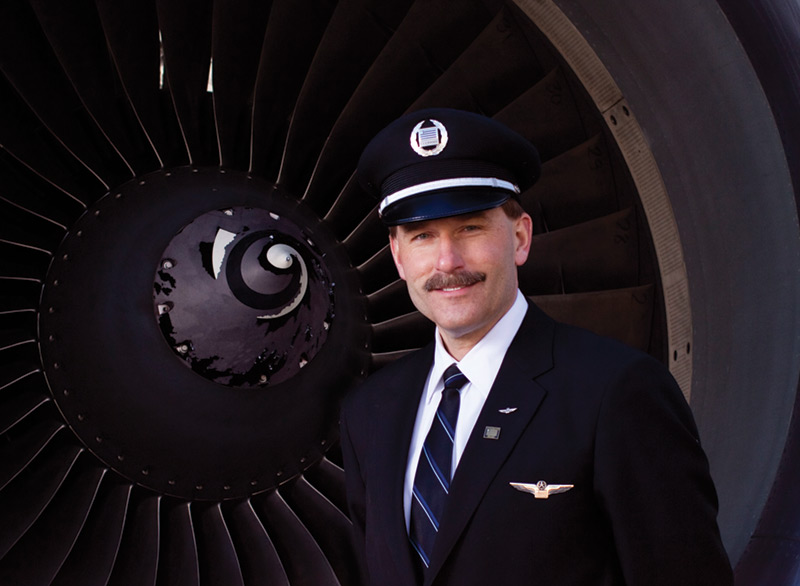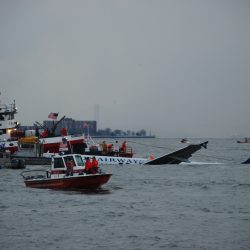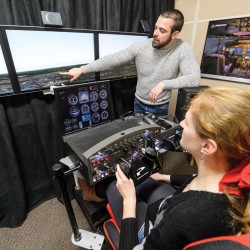This is Your Copilot Speaking

Jeff Skiles poses in front of the engine of an Airbus A320, similar to the plane he copiloted on Flight 1549. This picture was taken at Madison’s Dane County Regional Airport, where Skiles flew while he was a UW student. Photo: Brent Nicastro.
Jeff Skiles ’84 catapulted to fame by plummeting out of the sky.
As the copilot on US Airways Flight 1549, now popularly known as “the Miracle on the Hudson,” he and the flight’s captain, Chesley “Sully” Sullenberger, safely guided their damaged plane — and its 150 passengers and five crew members — onto the Hudson River. Like most airline pilots, Skiles is well aware of how little attention travelers typically pay to aircrews. All America has heard the outline of events. To show we’re listening, we offer you the events of Flight 1549, in Skiles’s own words.
The Airbus A320
This was only my second trip on that airplane. I’d been flying a Boeing 737 out of Philadelphia for the last eight years, and I’d just gone through training [on the Airbus A320] in December. You only fly one aircraft at a time, for training purposes, because they have different procedures — a Boeing will have different procedures from an Airbus. I’d flown a trip the previous week with a training captain — that’s a kind of flight instructor in the airline business — and this was my first trip without training wheels, so to speak. I’d never flown with anybody [in Flight 1549’s crew] until I’d met them that Monday [three days before the accident].
“Goosed”
I was flying the airplane — hand-flying, meaning the autopilot wasn’t on. We just saw the birds very briefly. People ask, ‘Why didn’t you just fly around them?’ Well, when you’re going about 250 miles an hour, by the time you see [birds], there just isn’t time to do anything about [them]. An airplane just does not maneuver fast enough to fly around them. Anyway, my recollection of it is that I saw them start to go down in the windscreen, and I thought, ‘Oh, good — they’re going to go beneath us.’ And then I heard the birds impact the airplane: boom-boom-boom-boom. Then the engines — in an Airbus, the engines make a real whiny sound in climb, and then in cruise, they get real quiet. This time, they had the high whine of the climb power, and then after the impacts, both engines, the right and then the left, went pssssshw, which is the sound they make when they go back to idle. And then, of course, we’re in a glider.
Fear
People have asked me, “Were you scared?” I think people are scared of things they don’t know and don’t understand. A pilot, in general, is not in this situation. So sure, there was a shock. The engines have failed. But then there’s things you have to do, and that helps you get through the shock. [The training procedures are] almost like a choreographed dance. You learn it, and then you do it every [trip], and that actually helps you, because you know you can do your normal duties without even thinking.
In my case, I knew I had to grab what we call the QRH, the quick reference handbook, which is essentially a checklist. Then I’ve got to find the right page, and there’s a three-page-thick list of procedures, and the pages are long. It’s really designed for going through at 25,000 or 30,000 feet. I never even got through the first page before we were in the water.
The Hudson
The river was our only option. Everybody seems to think this is horrible, but it’s actually a flat, open space. It’s not going to be great, but relative to landing in traffic, it’s not bad. It’s not like I had any oh-my-God-this-is-the-end moment. I just thought: River. Okay, we can do the river. It’s not that different from landing on a runway — you just don’t put the landing gear down. [But] it worked out far better than I could ever have imagined. I’d recommend ditching [a plane] to anybody.
Passengers
We made the brace-for-impact warning maybe a minute, minute and a half before landing. That’s a guess — it’s not like I was looking at a clock. Then the flight attendants begin giving instructions, and it’s almost like a chant: heads down, stay down, heads down, stay down. They’re trying to get the passengers into the braced position, which of course [none of the passengers] know, because they didn’t read the [safety briefing] card, because instead they were reading the paper.
After we landed, I had to go back into the cabin to do an evacuation check. It was probably forty-five seconds or a minute after we landed before I could get back there, and by that time, half the passengers were already gone. They were out on the wings or in the rafts. The other half were getting out fast. But none of them had taken any flotation devices with them. Like I said, it’s hard to get people to pay attention when they’ve got the Wall Street Journal in front of their faces.
Rescue
It was very fortunate that we came to rest where we did, I found out later, because that was right where the ferries make their crossings. By the time I got to the raft, a nice small boat was coming to pick us up — one that we could just step right into. But some ferry came along, and he decided that he was going to be the one to save our raft. He came barreling in and pushed the other boat out of the way. This thing was like ten feet up to the deck. So now, instead of being able to crawl right into a boat, we’ve got to scale the side. They threw down a boarding net, and it was like D-Day.
Critical attention
I don’t know who decided it, but afterward, somebody said we absolutely had to go to the hospital, even though four of us [all but flight attendant Doreen Welsh, who suffered a lacerated leg] were fine. So they took us to the hospital, and that took a long time. Everything took forever. And what strikes me is that everybody was talking around us — the police were talking amongst each other in little groups; the union guys are talking to each other. Nobody’s talking to us. It’s almost like we were pariahs.
Aftermath
I talked to a flight attendant — not one of the ones on that trip, but another one. And she said it was really funny: in the week after [the accident], all the passengers on her flights had their cards out and were following along. She’d never seen that in thirty years of flying.
Published in the Summer 2009 issue



Comments
Donna Herhuth March 18, 2024
Amazing. I’ve read Sully’s book, seen documentaries by Sully, Jeff and Patrick. Wonderful job , “ while doing their jobs”.
Timothy Dyck November 23, 2024
I would like to wish Jeff Skiles a long and happy retirement.
Dan January 2, 2025
One I’ll always look up to and admire. South Korea’s in the news lately, bird strikes, again. What went so wrong?